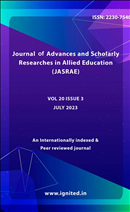Deep Learning Algorithms for Identifying Defects in Concrete Structures
Keywords:
Deep Learning Algorithms, Identifying Defects, Concrete Structures, Cracks, Pavement Maintenance, Digital Image Processing Methods, Convolutional Neural Networks, High-Quality Images, Manual Inspections, Subjective ExperienceAbstract
The presence of cracks is often the first sign of deterioration in concrete pavement. Detectingand addressing these cracks early on is crucial for effective pavement maintenance. Deep learningalgorithms, continuously advancing with improvements in computer hardware, offer a more accurate andautomated approach to crack detection compared to traditional digital image processing methods. Thishas sparked interest in researching concrete pavement crack images, as it promises enhancedresilience. Among deep learning techniques, convolutional neural networks (CNNs) have beenspecifically developed for automatic analysis of concrete surface photographs in crack diagnosisapplications. Despite the high accuracy claimed by deep learning-based systems, it is crucial toconsider an alternative perspective that highlights the neglect of challenges related to obtaining highqualityimages. the limitations of manual inspections, which are time-consuming and subjective, byproposing an alternative approach that streamlines the process. By reducing the reliance on subjectiveexperience, this approach improves efficiency and minimizes the potential for errors in detecting visualindications of stress, wear, and strain, such as cracks and depressions. Such indications, if leftunattended, can gradually lead to failure or collapse, especially when they occur in critical areas likeload-bearing joints.References
Bernard Budiansky; Richard J. O'connell (1976). Elastic moduli of a cracked solid. Int. J. Solids Struct. Vol 12, pp.81– 97.
Jacob Aboudi (1987). Stiffness reduction of cracked solids. Engineering Fracrure Mechanics Vol. 26. No. 5, pp. 637-450.
Mohan, Arun; Poobal, Sumathi (2017). Crack detection using image processing: A critical review and analysis. Alexandria Engineering Journal.
Mohan, A.; Poobal, S. Crack detection using image processing: A critical review and analysis. Alex. Eng. J. 2018, vol.57, pp787–798.
Kim, J.J.; Kim, A.R.; Lee, S.W. Artificial Neural Network-Based Automated Crack Detection and Analysis for the Inspection of Concrete Structures. Appl.Sci. 2020, vol 10, 81-05.
Cha, Y.J.; Choi, W.; Büyüköztürk, O. Deep Learning-Based Crack Damage Detection Using Convolutional Neural Networks. Comput.-Aided Civ. Infrastruct. Eng. 2017, vol 32, pp 361–378.
Jang, K.; Kim, N.; An, Y.K. Deep learning-based autonomous concrete crack evaluation through hybrid image scanning. Struct. Health Monit. 2019,vol 18, pp1722–1737.
Andrushia, A.D.; Lubloy, E. Deep learning based thermal crack detection on structural concrete exposed to elevated temperature. Adv. Struct. Eng. 2021, vol 24, pp 1896–1909.
R.Ali, L.; Alnajjar, F.; Jassmi, H.A.; Gocho, M.; Khan, W.; Serhani, M.A. for Performance Evaluation of Deep CNN- Based Crack Detection and Localization Techniques Concrete Structures. Sensors 2021, vol 21, pp 16-88.
Choudhary, G.K.; Dey, S. Crack detection in concrete surfaces using image processing, fuzzy logic, and neural networks. In Proceedings of the 2012 IEEE Fifth International Conference on Advanced Computational Intelligence(ICACI), Nanjing, China, 18–20 October 2012; pp. 404–411.
Ha, T.D. Computer vision-based method for concrete crack detection. In Proceedings of the 2016 14th International Conference on Control, Automation, Robotics and Vision (ICARCV), Phuket, Thailand,pp 13–15 November 2016.
M. Pal, P. Palevičius Mantas, L. U. Orinaitė, I. Timofejeva and M. Ragulskis. An Overview of Challenges Associated with Automatic Detection of Concrete Cracks in the Presence of Shadows Sci. 2021, 11(23), 11396
P. KUMAR, A. SHARMA AND S. R. KOTA Automatic Multiclass Instance Segmentation of Concrete Damage Using Deep Learning Model Digital Object Identifier 10.1109/ACCESS.2021.3090961
A.Sathesh, Edriss Eisa Babikir Adam Construction of Accurate Crack Identification on Concrete Structure using Hybrid Deep Learning Approach Journal of Innovative Image Processing (JIIP) (2021) Vol.03, pp 85-99.
L. ZHANG, G. ZHOU, Y. HAN , H. LIN, Y. WU Application of Internet of Things Technology and Convolutional Neural Network Model in Bridge Crack Detection Laboratory of Engineering Computing, North China University of Science and Technology, Tangshan 063000, China.
Barkavi, T. and Natarajan, C. Processing Digital Image for Measurement of Crack Dimensions in Concrete Civil Engineering Infrastructures Journal, 52(1): 11 – 22, June 2019.
V. P. Golding, Z. Gharineiat , H. S. Munawar and F. Ullah. Crack Detection in Concrete Structures Using Deep Learning Using Deep Learning. Sustainability 2022,vol 14,pp 81-17.
Paulius P.c. , Mayur P. , Mantas L. , Ugn˙e O. , Inga T. and Minvydas R. Automatic Detection of Cracks on Concrete Surfaces in the Presence of Shadows vol 22,pp36-62.
E.Shahrokhinasab 1 , N. Hosseinzadeh , A. Monir A. , S. Torkaman Performance of Image Based Crack Detection Systems in Concrete Structures, Journal of Soft Computing in Civil Engineering Vol 4, Number 11 January 2020 pp 127-139.
Shengyuan L. Xuefeng Z. Guangyi Z. Automatic pixel-level multiple damage detection of concrete structure using fully convolutional Computer-Aided Civil and Infrastructure Engineering, (), –.doi:10.1111/mice.12433
H. M. La, T. H. Dinh, Q. P. Ha Computer Vision-based Method for Concrete Crack Detection International Conference on Control, Automation, Robotics & Vision Phuket, Thailand, 13-15th November 2016.
X. Meng Concrete Crack Detection Algorithm Based on Deep Residual Neural Networks Hindawi Scientific Programming Volume 2021.
Ankang J., X. Xuea, Y. Wangb, X. Luoc, W. Xued An integrated approach to automatic pixel-level crack detection and quantification of asphalt pavement Automation in Construction 114 (2020)pp 103-176.
Karthik Subhash damage detection in beam.
R. Ali , J. H. Chuah a, M. S. A. Talip a, N. Mokhtar , M. A. Shoaib Structural crack detection using deep convolutional neural networks Automation in Construction Vol 133, January 2022, pp 103-989.
Ç.F. Özgenela and A. G. Sorguçb Performance Comparison of Pretrained Convolutional Neural Networks on Crack Detection in Buildings.











